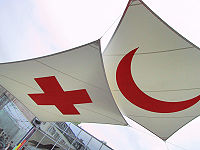
Photo from wikipedia
Objective UAV-based multispectral detection and identification technology for ground injured human targets, is a novel and promising unmanned technology for public health and safety IoT applications, such as outdoor lost… Click to show full abstract
Objective UAV-based multispectral detection and identification technology for ground injured human targets, is a novel and promising unmanned technology for public health and safety IoT applications, such as outdoor lost injured searching and battlefield casualty searching, and our previous research has demonstrated its feasibility. However, in practical applications, the searched human target always exhibits low target-background contrast relative to the vast and diverse surrounding environment, and the ground environment also shifts randomly during the UAV cruise process. These two key factors make it difficult to achieve highly robust, stable, and accurate recognition performance under the cross-scene situation. Methods This paper proposes a cross-scene multi-domain feature joint optimization (CMFJO) for cross-scene outdoor static human target recognition. Results In the experiments, we first investigated the impact severity of the cross-scene problem and the necessity to solve it by designing 3 typical single-scene experiments. Experimental results show that although a single-scene model holds good recognition capability for its scenes (96.35% in desert scenes, 99.81% in woodland scenes, and 97.39% in urban scenes), its recognition performance for other scenes deteriorates sharply (below 75% overall) after scene changes. On the other hand, the proposed CMFJO method was also validated using the same cross-scene feature dataset. The recognition results for both individual scene and composite scene show that this method could achieve an average classification accuracy of 92.55% under cross-scene situation. Discussion This study first tried to construct an excellent cross-scene recognition model for the human target recognition, named CMFJO method, which is based on multispectral multi-domain feature vectors with scenario-independent, stable and efficient target recognition capability. It will significantly improve the accuracy and usability of UAV-based multispectral technology method for outdoor injured human target search in practical applications and provide a powerful supporting technology for public safety and health.
Journal Title: Frontiers in Public Health
Year Published: 2023
Link to full text (if available)
Share on Social Media: Sign Up to like & get
recommendations!